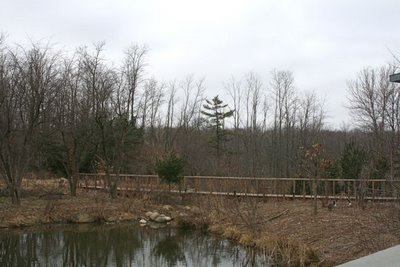
The Lab of Ornithology appears to me to have been designed around two major aesthetic concerns. First, the trove of bird art, like that in the Fuertes library and the Fisher’s Island panel, which have been beautifully integrated into the space. A second goal was to showcase the natural wonders in the wetlands just outside, visible through huge windows all around. It’s like the biggest blind you’ve ever seen.
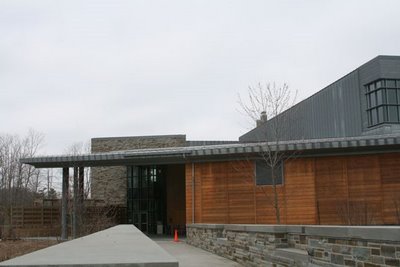 Though my time was limited, I was determined to take in just a bit of the gorgeous swampy bit of Sapsucker Woods immediately around the building. It’s truly another world, quiet, laced with mulched paths, swarming with birds. Canada geese were living their lives, getting it on,
Though my time was limited, I was determined to take in just a bit of the gorgeous swampy bit of Sapsucker Woods immediately around the building. It’s truly another world, quiet, laced with mulched paths, swarming with birds. Canada geese were living their lives, getting it on,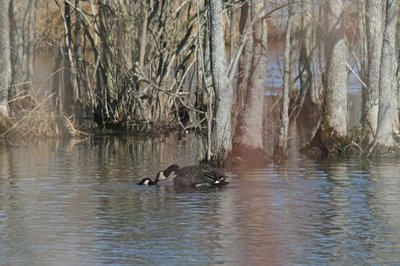 preening
preening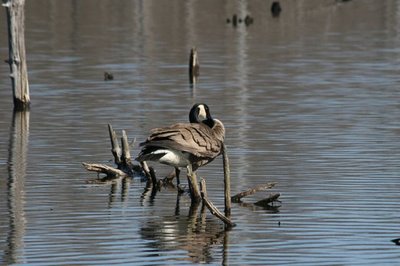
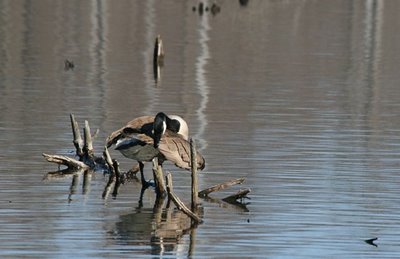
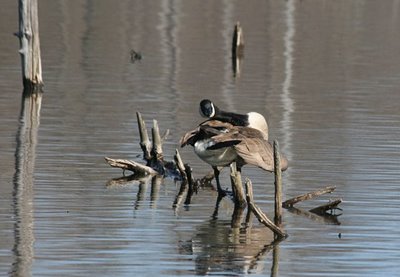 and making a general honking ruckus. One pair has claimed ownership of a part of the path near the bird feeder, and challenges passersby in a quiet way. I saw several toddlers try to pet this bird. Not recommended.
and making a general honking ruckus. One pair has claimed ownership of a part of the path near the bird feeder, and challenges passersby in a quiet way. I saw several toddlers try to pet this bird. Not recommended.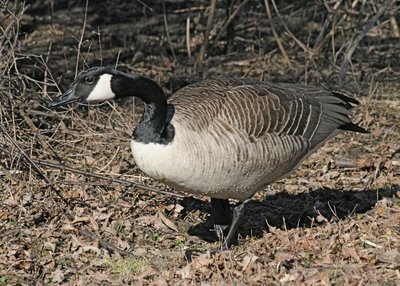 Does this goose look intelligent to you?
Does this goose look intelligent to you? 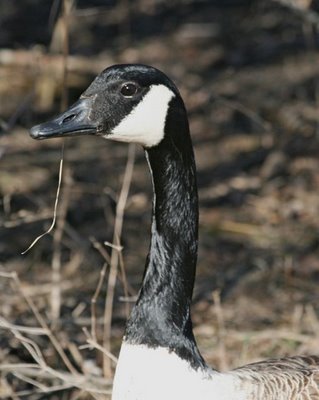 It does to me. There's really something going on in those eyes. It hisses and intimidates people who come too close. You don’t want a bite from that bony, serrated bill. There were a couple of geese with permanently injured wings, making a good living, mates by their side, at the pond. One bird acts as an unofficial greeter, hanging out right by the entry. It's neat to see birds the second you pull into the parking lot of the Lab.
It does to me. There's really something going on in those eyes. It hisses and intimidates people who come too close. You don’t want a bite from that bony, serrated bill. There were a couple of geese with permanently injured wings, making a good living, mates by their side, at the pond. One bird acts as an unofficial greeter, hanging out right by the entry. It's neat to see birds the second you pull into the parking lot of the Lab.Mallards kept bombing over and dropping in, and I played at photographing them, with some pretty cool results.
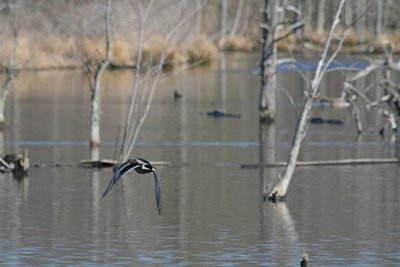 As a young bird painter, I devoured a book called Prairie Wings, by Edgar M. Queeney. Using the rudimentary black-and-white equipment of the time, he captured amazing photos of ducks in flight. If only I could go back in time and hand Mr. Queeney my little Digital Rebel. What fun he'd have.
As a young bird painter, I devoured a book called Prairie Wings, by Edgar M. Queeney. Using the rudimentary black-and-white equipment of the time, he captured amazing photos of ducks in flight. If only I could go back in time and hand Mr. Queeney my little Digital Rebel. What fun he'd have.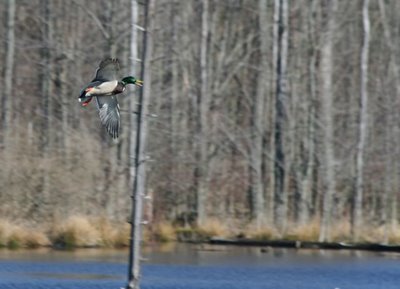
A mushmouse swam by a resting hooded merganser (the white spot directly back of the rat).
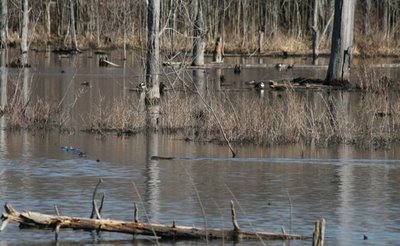
A pair of common mergansers.
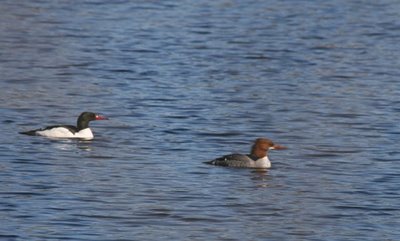 When they hauled out on a log, I could see the bulk of their bodies. They’re like icebergs.
When they hauled out on a log, I could see the bulk of their bodies. They’re like icebergs.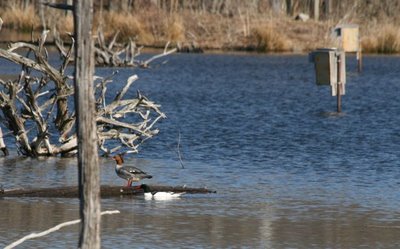 Note the wood duck nesting boxes, which common and hooded mergansers may also use. The place is set up for birds, and the resident geese know and exploit that.
Note the wood duck nesting boxes, which common and hooded mergansers may also use. The place is set up for birds, and the resident geese know and exploit that.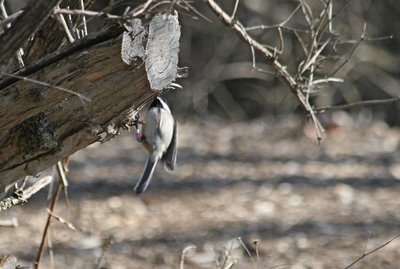 I had to chuckle when the black-capped chickadee I photographed turned out, on closer inspection, to be color-banded. This is the Lab of Ornithology, after all. Who knows what secrets these birds have revealed?
I had to chuckle when the black-capped chickadee I photographed turned out, on closer inspection, to be color-banded. This is the Lab of Ornithology, after all. Who knows what secrets these birds have revealed?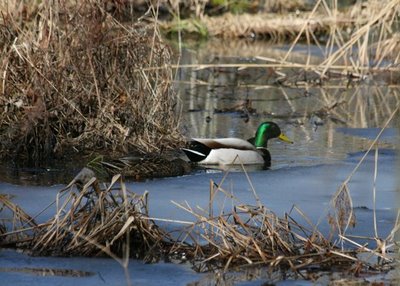 The incandescent glow of a mallard’s head. His mate hides in shadow.
The incandescent glow of a mallard’s head. His mate hides in shadow.I was stunned to see a big brown bat flying in daylight, dipping down to drink.
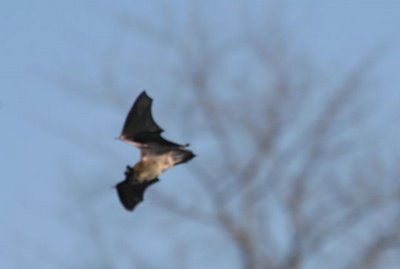 I never thought my photos would be acceptable, but they aren’t bad, considering that I was focusing manually, and the bat was dipping and diving like, well, a bat.
I never thought my photos would be acceptable, but they aren’t bad, considering that I was focusing manually, and the bat was dipping and diving like, well, a bat. 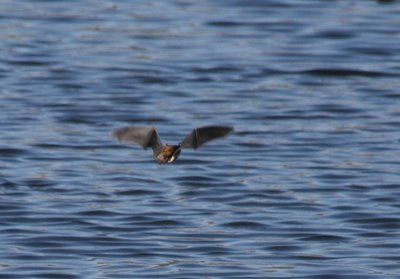 This is a really neat shot, and it's even, finally, in good focus.
This is a really neat shot, and it's even, finally, in good focus.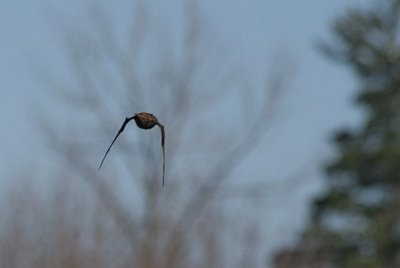 I hoped he wasn’t ill; bats all over the Northeast are turning up with “white-nose syndrome,” a disease of apparently fungal origin that is killing them by the thousands, and sending them out of their hibernacula much too early. Please be well and travel safely, brown bat.
I hoped he wasn’t ill; bats all over the Northeast are turning up with “white-nose syndrome,” a disease of apparently fungal origin that is killing them by the thousands, and sending them out of their hibernacula much too early. Please be well and travel safely, brown bat.This ends my sojurn at the Lab. The "Letters from Eden" show hangs through mid-July. Please check it out if you're in the area.






13 comments:
Thanks for sharing the photos. Very nice! I try to use my husband's digital rebel xti, but can never seem to get close enough...I may have to surprise him with a better lens.
Thank you for sharing your journey. The art, the comments, the pictures are wonderful.
The more I see old photographs, the more I am amazed at the photographer's skills. I, too, try to imagine their wonder at today's digital imaging.
Yes, thanks for this glimpse of Cornell's Lab of Ornithology for those of us who've never been, but who've certainly been influenced by it over the yrs.
On a separate note, scientist Chet Raymo has a particularly interesting (and long) post over at his blog currently which 'science chimps' everywhere might find of interested:
http://www.sciencemusings.com/
Has to do with communicating science to children; something the resident science chimp here might even want to add some thoughts to in a future post....
I was at Sapsucker Woods recently and was happy to see your show.
How did you drive the nine hour trip by yourself?!
Thanks for writing about your trip to Ithaca and the Lab. You've really captured the spirit of the locales with your words and pictures.
Amy, I love the 70-300 Canon image-stabilized lens. It's affordable, light and nimble. Birthday?
NCMtFemale: Wouldn't you love to be able to plop a nice digital SLR in Ansel Adams' or Artur Allen's hands (to name just two outstanding nature photographers with the initials AA)?
Cyberthrush, just had the kids out hunting morels and checking bluebird boxes this afternoon. Always looking for hooks to get them off the computer and out in the woods. They love it once they're lured out! I'll check out the link.
Jana, I had Chet Baker by my side the whole 9 1/2 hours each way, alternately giving kisses and fumigating the car interior. No way to fall asleep with entertainment like that. I just took a 2 1/2 hour drive on Sat. to give a talk and on the way home, I had to pull over and go to sleep. I had gotten up at 4:45 to make it to the morning birdwalk. A guy came up to see if I was OK. Oh, I'm fine, just drooling on the car seat...I don't know who was more embarrassed.
Fantastic photos, Julie! Your bat photo is the first I've seen in flight.
I've enjoyed your tour of the famous lab and appreciate your focus on the more common birds we see every day.
LOVED the last bat shot. I hope "white-nose" doesn't spread to this neck of the woods. We have a bazillions bats at RAPTOR and it's bad enough to have them swooping when I bring birds back at night. IF they are falling into my hair, sick and disoriented....bleh.
mushmouse?
Such a neat place. Wish I lived closer and could visit. I am sure your exhibit will be bringing joy to so many Julie. :c)
Birthday is what I was thinking...it's coming up in several months. Do you find that you need to change lenses often to take family snapshots, etc?
Amy, I carry both lenses wherever I go. In spring, I keep the telephoto on all the time, because I'm mostly shooting birds, and it works fine for flowers as long as you back away. If I'm going to a family function or shooting bluebird nests, I put the portrait (135mm) lens on. I try to keep whatever lens that's not on the camera in the pocket of my photo vest so I'm ready. Real pros buy several camera bodies and festoon themselves with their landscape, bird, and macro cameras, but I don't want to lug that much around. The general rule for me is that I keep the telephoto on my camera body, because I need to be ready to shoot before the bird flies away. If I see a flower, kidshot or scenic I want, I can always change out to the shorter portrait lens--those don't fly away.
Thank you!
Awesome bat pix, J!
Post a Comment